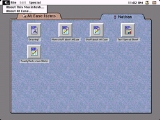
At Ease
Encyclopedia
At Ease was an alternative to the Macintosh desktop
Desktop computer
A desktop computer is a personal computer in a form intended for regular use at a single location, as opposed to a mobile laptop or portable computer. Early desktop computers are designed to lay flat on the desk, while modern towers stand upright...
developed by Apple Computer
Apple Computer
Apple Inc. is an American multinational corporation that designs and markets consumer electronics, computer software, and personal computers. The company's best-known hardware products include the Macintosh line of computers, the iPod, the iPhone and the iPad...
in the early 1990s. It provided a simple environment for new Macintosh users and young children to help them to work without supervision. At Ease sits on top of the Finder
Macintosh Finder
The Finder is the default file manager used on Mac OS and Mac OS X operating systems; it is responsible for the overall user-management of files, disks, network volumes and the launching of other applications...
desktop, providing a simple tab panel oriented graphical user interface
Graphical user interface
In computing, a graphical user interface is a type of user interface that allows users to interact with electronic devices with images rather than text commands. GUIs can be used in computers, hand-held devices such as MP3 players, portable media players or gaming devices, household appliances and...
in which applications
Application software
Application software, also known as an application or an "app", is computer software designed to help the user to perform specific tasks. Examples include enterprise software, accounting software, office suites, graphics software and media players. Many application programs deal principally with...
and document
Document
The term document has multiple meanings in ordinary language and in scholarship. WordNet 3.1. lists four meanings :* document, written document, papers...
s are represented by icon
Icon
An icon is a religious work of art, most commonly a painting, from Eastern Christianity and in certain Eastern Catholic churches...
s on large buttons. Aside from its security features, its interface and basic functionality is very similar to the Packard Bell Navigator
Packard Bell Navigator
Packard Bell Navigator was an alternative shell for the Windows 3.1 and Windows 95 operating systems that shipped with Packard Bell computers. The shell was designed to be simpler to use for computer novices by representing applications as objects in a virtual home, similar to Microsoft Bob and At...
.
Features
- Panels: at the main At Ease desktop, there are two "panels" which are accessed with tab buttons. One displays your applications and one displays your personal documents. When a panel is full, another is created and you must change the current page.
- Multiple users: at the time At Ease was released, System 7System 7 (Macintosh)System 7 is a single-user graphical user interface-based operating system for Macintosh computers. It was introduced on May 13, 1991 by Apple Computer. It succeeded System 6, and was the main Macintosh operating system until it was succeeded by Mac OS 8 in 1997...
did not support multiple users. At Ease provided an easy and safe way for Macintosh users to store personal files on their computer and protect them from other people using the same computer. - Sharing: At Ease allows files to be shared with other users.
- Privileges: the main user (known as the "Administrator" or "Owner") can set what programs and documents the user has access to.
- Security: At Ease allowed passwords to be set for each user, to make sure that one user cannot log on to another user's account
At Ease for Workgroups
At Ease for Workgroups allows users to log on to a server from any workstation that has the At Ease software installed. At Ease for Workgroups introduced a number of network-specific features not found in the original At Ease. The workgroup version enabled client configuration, network access and restrictions on how the client's computer can be used. In addition to the beige-colored Applications "folder" and the blue-colored Documents "folder" that each user had in his or her account, the workgroup version of the software also would allow for easier access to removable media: a pink-colored folder would appear in the user's profile for any CD-ROM inserted into the computer and a green-colored folder would appear for a floppy disk. These features were controlled for each user by the administrator. At Ease for Workgroups also included an Administration program that can add users and workgroups to the network.At Ease for Workgroups 5 also provided a restricted Finder mode that allowed the Finder to operate instead of the traditional At Ease panels. It provided quick access to the user's documents folder which could be stored on an AppleShare IP server. The restricted Finder mode later turned into Mac OS 9's multiple users feature.
At Ease in Mac OS 9
Built-in support for multiple users was implemented into Mac OS 9Mac OS 9
Mac OS 9 is the final major release of Apple's Mac OS before the launch of Mac OS X. Introduced on October 23, 1999, Apple positioned it as "The Best Internet Operating System Ever," highlighting Sherlock 2's Internet search capabilities, integration with Apple's free online services known as...
, bringing all of the features straight into the Mac OS and thus eliminating the need to install and use a different environment.
Even though At Ease was discontinued, certain aspects of its user interface appear in later versions of Mac OS. For example Mac OS 8 and Mac OS 9 included the Platinum interface theme, which resembles At Ease. Its influence upon iOS, Apple's operating system for iPhone and iPad devices, has also been noted. There is also a similarity to the productivity-enhancing Launcher Control Panel, in Mac OS 7 and 8.

